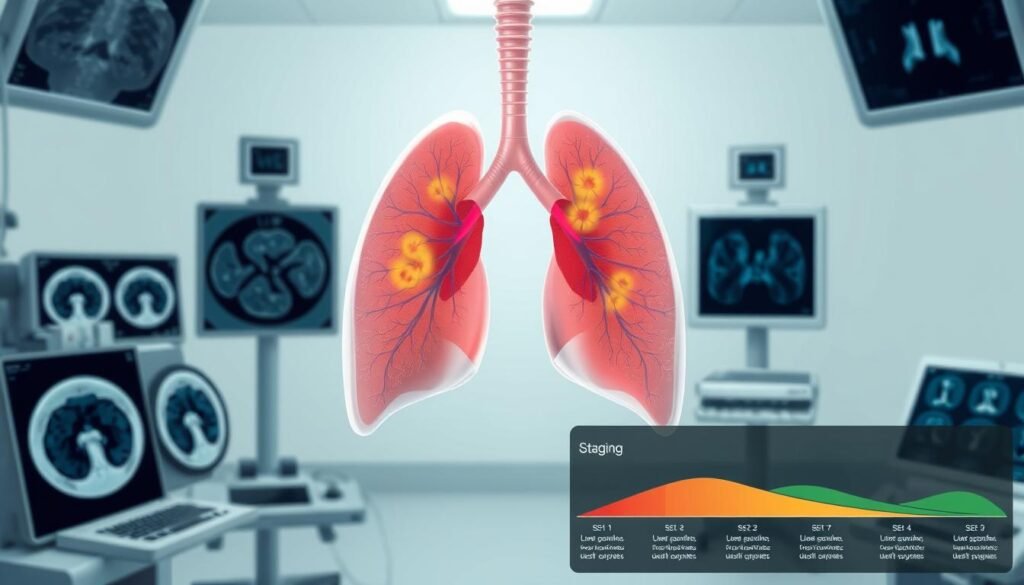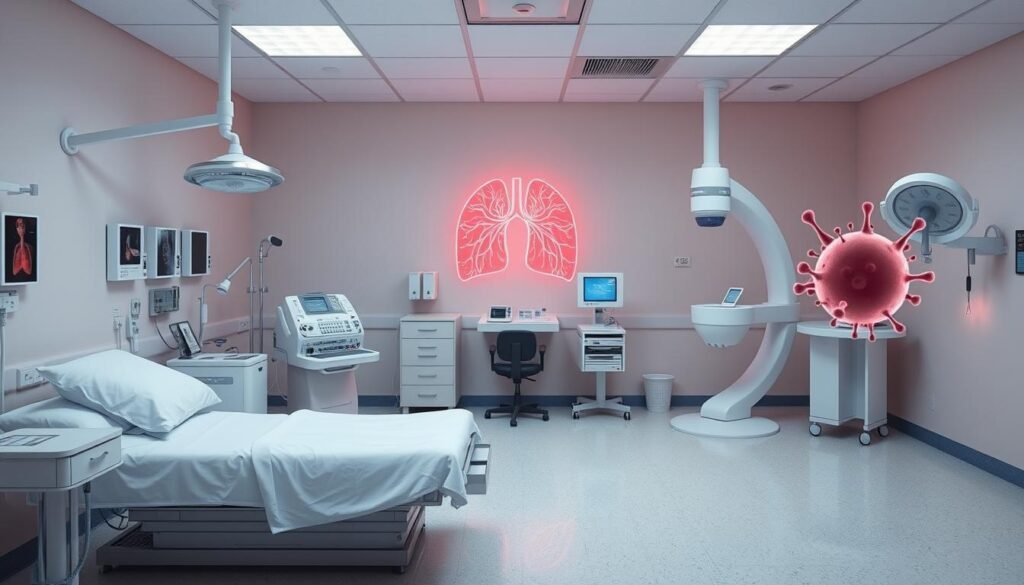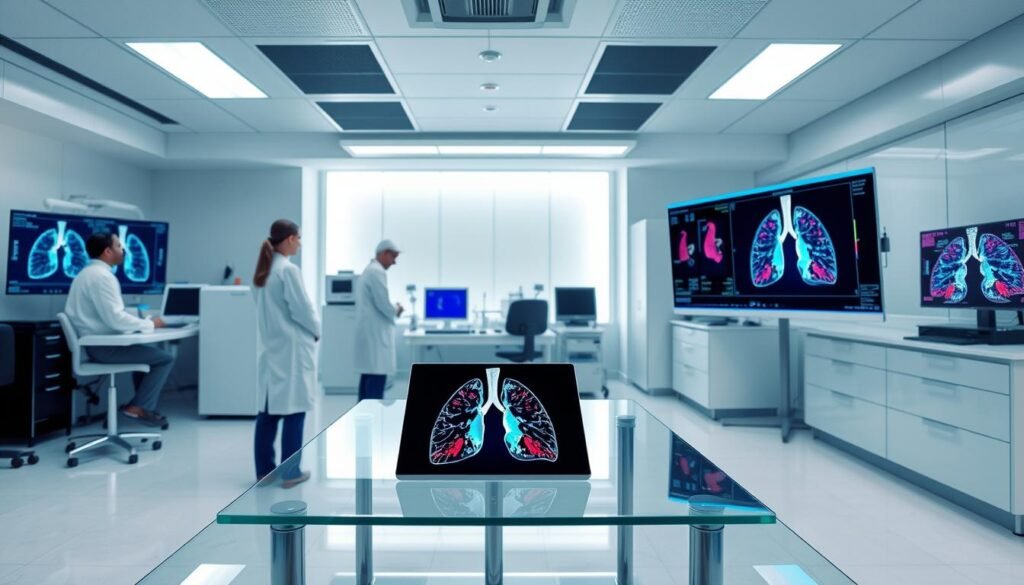Over half of the people with non-small cell lung cancer (NSCLC) learn about their condition late. When it’s already at an advanced stage. This fact underscores the urgent need for awareness and education on inoperable lung cancer and its treatments. Inoperable lung cancer, or unresectable lung cancer, means tumors can’t be removed by surgery. This can be because of how far the cancer has spread, where it’s located, or the patient’s health. Yet, it’s key to know there are many treatment options out there that don’t require surgery.
Patients and their families have various treatments to look into. These treatments focus on managing symptoms, shrinking the tumor, and bettering life quality. Knowing about these options is vital in handling inoperable lung cancer. There are new therapies and support available that help keep hope alive and aim for improved health. For those who want to know more about radiation therapy, check out this comprehensive guide.
Key Takeaways
- Many with NSCLC are diagnosed at advanced stages, complicating treatment options.
- Inoperable lung cancer offers multiple treatment pathways aside from surgery.
- Advanced lung cancer treatment focuses on symptom management and quality of life enhancement.
- Understanding each treatment option is crucial for patients and their families.
- Improving treatment outcomes is possible due to ongoing advancements in lung cancer therapies.
What is Inoperable Lung Cancer?
Inoperable lung cancer means doctors can’t remove the tumor with surgery. This might be because of its size, where it is, or if it has spread. It’s important to know about this to look at treatment options and help patients.
There are two main types of lung cancer: non-small-cell lung cancer (NSCLC) and small-cell lung cancer (SCLC). NSCLC makes up about 80% of cases. It has three kinds: adenocarcinoma, squamous cell carcinoma, and large-cell carcinoma. SCLC, about 10-15% of cases, grows fast and is often from smoking. It usually spreads by the time it’s found.
Stage 4 NSCLC is especially tough, as it can’t be treated with surgery. The cancer may spread to the pleura, heart, or other places. So, treatment looks at other ways to control it. Catching it early is key.
Now, there are new treatments like immunotherapy and targeted therapy. They work well for many lung cancer patients. These treatments boost the immune system or attack cancer cells directly, sparing healthy cells.
| Lung Cancer Type | Percentage of Cases | 5-Year Survival Rate |
|---|---|---|
| Non-Small-Cell Lung Cancer (NSCLC) | Approximately 80% | 25% overall; 63% if localized |
| Small-Cell Lung Cancer (SCLC) | 10-15% | 7% overall; 27% if localized |
Causes and Risk Factors for Inoperable Lung Cancer
Lung cancer is a major health issue, mainly caused by smoking. This habit is behind about 80% of lung cancer deaths. Smokers are at a ten times higher risk than non-smokers. Even after quitting, former smokers still face risks for many years.
Environmental factors also affect lung cancer risk. Being around radon gas, asbestos, and other workplace carcinogens can raise your risk. Radon exposure alone leads to about 21,000 lung cancer deaths each year in the USA. Air pollution, too, adds to the risk, causing around 8% of lung cancer deaths.
Don’t forget the role of genetic predisposition in lung cancer. If lung cancer runs in your family, your risk is higher, especially if you smoke. Chronic lung issues, like COPD, also play a part by limiting treatment options. That’s why understanding these lung cancer risk factors is crucial for prevention and early detection.
| Risk Factor | Impact on Lung Cancer Risk |
|---|---|
| Smoking | 10-fold increase for smokers vs. non-smokers |
| Former Smoking | Elevated risk persists for years after quitting |
| Radon Exposure | Linked to approximately 21,000 deaths annually |
| Asbestos Exposure | Increases lung cancer incidence significantly |
| Family History | Higher risk, particularly in conjunction with smoking |
| Air Pollution | Associated with an 8% increased risk of lung cancer mortality |
Symptoms of Inoperable Lung Cancer
It’s tough to spot inoperable lung cancer early because the signs are often hidden. A persistent cough is one such sign. At first, it might look like a simple cold. But as cancer grows, chest pain may start, feeling different and not always linked to coughing.
Difficulty breathing is a major sign. It means getting out of breath doing daily things, which becomes hard and exhausting. Fatigue is another big issue, making people feel very tired all the time. Other signs include losing weight without trying or having a rough voice from throat irritation.
Many overlook these signs, thinking they’re not a big deal. This waiting can make things worse. Realizing these signs early is key to getting checked out soon. For more info on inoperable lung cancer, check out this article for helpful details.
Diagnosis and Staging of Lung Cancer
Lung cancer diagnosis uses imaging tests like X-rays, CT scans, MRIs, and PET scans. These help see tumors and check if they’ve spread. These tests are key to understanding how far the cancer has gone.
To confirm cancer, doctors do biopsies, taking a tissue sample to look for cancer cells. Imaging tests and biopsies together help stage the lung cancer. This stage is important for planning treatment.

Cancer stages go from 0 to IV, depending on tumor size and if it has spread to lymph nodes or further. Non-small-cell lung cancer can be stages IIA, IIB, or II, with more details based on lymph node status. Stage III means the cancer has spread more, and IV is the most advanced.
Before treatment, patients might get checked to see if cancer reached chest lymph nodes. Doctors might use techniques like EBUS-TBNA or mediastinoscopy for precise staging. After surgery, the cancer stage might get updated with new information.
Knowing the stage of lung cancer is key for choosing treatments and understanding prognosis. While it shows how much the cancer has spread, it doesn’t tell how long someone will live. Tailored treatments are made based on the cancer stage and the patient’s health.
Inoperable Lung Cancer: Why Surgery is Not an Option
For patients with inoperable lung cancer, surgery might not be an option. This is due to critical factors. Tumors may be located where surgery can’t reach them. This happens when cancer has spread too much. In such cases, called “unresectable,” options for treatment become limited.
How well the patient is health-wise also matters a lot. Issues like heart disease or chronic lung problems can make surgery too risky. Instead, doctors may suggest other treatments. Chemotherapy and radiation therapy are usually the go-to options. Chemo cycles last up to four weeks. Radiation therapy takes five to seven weeks. Side effects can include feeling tired and sick.
New treatments have also come up. Targeted therapies work against specific gene changes, like EGFR and ALK mutations. Drugs for immunotherapy, such as Nivolumab and Pembrolizumab, boost the immune system against cancer. This gives hope to those with inoperable lung cancer.
Knowing about these treatments can help patients and families decide on care. Palliative care is also crucial. It focuses on easing symptoms and improving life quality.
Lung Cancer Treatment Options Beyond Surgery
People with inoperable lung cancer have several non-surgical treatment options. These treatments aim to manage the disease and better the patient’s life. They are tailored to meet individual needs and the nature of the tumor.
Chemotherapy: Killing Cancer Cells
Chemotherapy uses drugs to target and destroy quickly multiplying cancer cells. It’s a systemic treatment, meaning it works throughout the body. These drugs can be taken by mouth or injected. Often, they are part of a combination of treatments to improve outcomes.
Radiation Therapy: Targeting Tumors
Radiation therapy uses intense rays to kill or slow the growth of cancer cells. It can be delivered from outside or inside the body. Techniques like SBRT and Proton Therapy allow for precise targeting. When paired with chemotherapy, it forms a powerful treatment approach.
Targeted Therapy: Precision Medicine for NSCLC
Targeted therapy focuses on the genetic changes in tumors. Drugs like Sotorasib (Lumakras) and adagrasib (Krazati) work on tumors with the KRAS mutation. Another drug, necitumumab (Portrazza), targets EGFR gene changes. This method causes less harm to normal cells, which means fewer side effects. It offers a more customized way to tackle lung cancer.

| Treatment Type | Mechanism | Indications | Special Considerations |
|---|---|---|---|
| Chemotherapy | Medications target fast-growing cancer cells | Used for various lung cancer types | Can lead to systemic side effects |
| Radiation Therapy | High-energy rays destroy or inhibit growth of cells | Localized treatment for tumors | Specialized forms available like SBRT and Proton Therapy |
| Targeted Therapy | Drugs specifically attack mutations in cancer cells | Prescribed for patients with specific gene mutations | Less impact on healthy cells, tailored treatments |
Choosing a treatment depends on cancer type, stage, and personal health. Doctors create personalized plans to best manage the disease. This helps improve the quality of life for those affected.
Immunotherapy: Boosting the Body’s Defense
Immunotherapy is a key player in battling lung cancer. It boosts the body’s defenses to find and kill cancer cells. By using the body’s own systems, immunotherapy strengthens our fight against tough cancers. This is especially true for lung cancer that cannot be removed surgically.
How Immunotherapy Works
This therapy uses the body’s adaptive immune response. It gets B cells and T cells to team up. T cells are like soldiers. They attack tumors that hide from the immune system. It’s been found that some cancer cells can turn off immune responses. Immunotherapy seeks to help the immune system find and destroy these tricky cells.
Current Immunotherapy Options for Lung Cancer
Now, there are several FDA-approved immunotherapy treatments for lung cancer. They mainly use immune checkpoint inhibitors. These drugs help the immune system fight cancer. For some, they can keep the tumor in check for up to three years. There are also other hopeful treatments:
- Adoptive T cell therapy: This involves changing a patient’s T cells to better fight cancer.
- Bispecific T-cell Engager (BiTE®) Therapy: This is useful for advanced small cell lung cancer. It helps the immune system attack certain cancer cells.
- Therapeutic vaccines: These are being tested in clinical trials. The goal is to make the immune system target cancer-specific proteins.
The way immunotherapy drugs are given depends on the type of lung cancer, any genetic mutations, past treatments, and the patient’s overall health. Researchers are always looking for new ways to use the immune system against lung cancer.
Including Clinical Trials in Treatment Decision-Making
Clinical trials are key for those battling inoperable lung cancer. They offer access to new treatments not yet public. These trials expand opportunities for patients, allowing them to try new therapies. At the same time, they help push lung cancer research forward.

Talking to healthcare pros about clinical trials can reveal options that fit patient needs. A review looked at 1,420 records from databases like MEDLINE and SCOPUS. It found 28 eligible trials, with 82% focusing on non-small cell lung cancer. This shows how vital research is across different lung cancer types.
- Most studies were Phase II/III trials, forming 61% of the eligible studies.
- Open-label trials made up 71% of the total, sharing crucial data on how well treatments work.
- A big 89.3% of trials included patients with advanced disease.
Henry Ford Cancer is a leader in this area, especially with trials on immunotherapy and advanced non-small cell lung cancer. This cancer center is one of the busiest with lung cancer trials in Michigan and across the country. With 20 clinical trials often open, Henry Ford Cancer has helped approve vital immunotherapy drugs like nivolumab (Opdivo®) and pembrolizumab (Keytruda®).
The role of clinical trials in lung cancer treatment is growing. Patients get access to the latest therapies. They also help shape the future of lung cancer research through their involvement.
Lung Cancer Prognosis and Survival Rates
Understanding lung cancer’s outlook and survival rates is vital for patients and their families. The prognosis changes based on many things, like the cancer type and stage when found. For example, non-small-cell lung cancer (NSCLC) has a five-year survival rate of about 24%. On the other hand, the five-year survival rate for small-cell lung cancer (SCLC) with advanced disease is around 6%.
Stage-Specific Survival Rates
Stage at diagnosis impacts lung cancer survival rates greatly. Here are the survival rates based on the cancer stage:
| Stage | 5-Year Survival Rate (NSCLC) | 5-Year Survival Rate (SCLC) |
|---|---|---|
| Stage 1 | 65% | 27% |
| Stage 2 | 40% | 16% |
| Stage 3 | 15% | 3% |
| Stage 4 | 5% | 3% |
This data shows early detection’s importance. Sadly, about 70% of SCLC is found after it has spread, which drops survival rates. That’s why care that meets each person’s needs is key to better outcomes.
Factors Influencing Prognosis
Many factors impact a lung cancer patient’s outlook. These include:
- The patient’s age.
- Other health issues.
- How well treatment works.
- The kind of lung cancer.
Tailored treatments can really change survival rates. Studies show that custom care for local disease can help a lot. Learn more about how personalized plans boost chances here.
Conclusion
It’s crucial for patients and their families to understand inoperable lung cancer and care options. Even without surgery, there are many ways to fight against the disease. These methods aim to extend life and improve quality of life for these patients.
Recent advances in lung cancer research, like immunotherapy and targeted treatments, offer new hope. These breakthroughs suggest that people with lung cancer could live longer. It’s important for patients to talk about their care, look at all options, and consider joining clinical trials.
Patients taking an active role in their care can change their treatment outcomes. Looking at all the options for inoperable lung cancer care is key. This approach helps patients stay strong and hopeful, even during tough times.